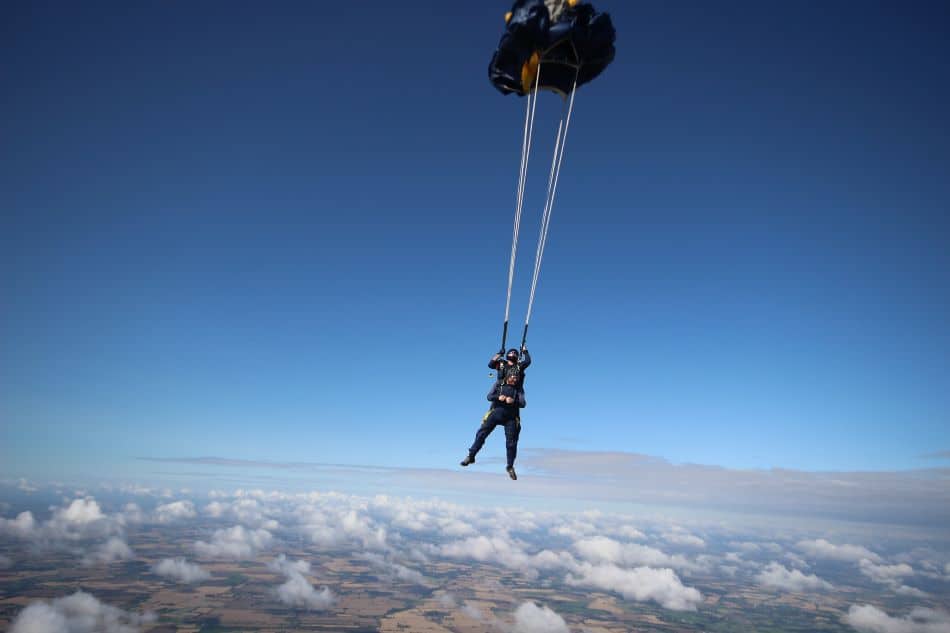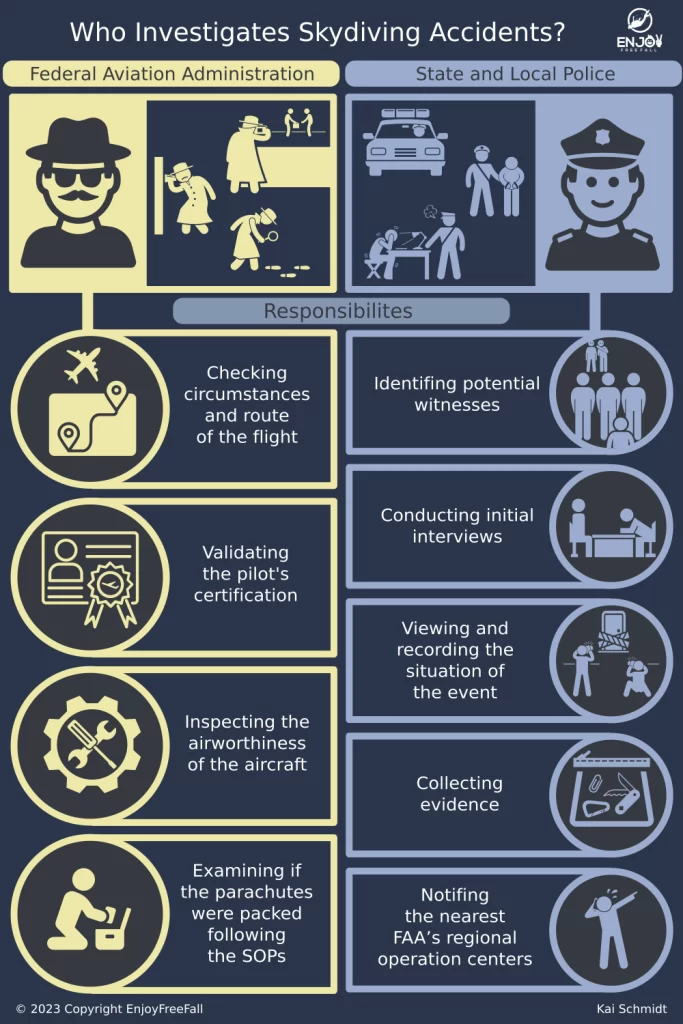
Although skydiving is a safe sport, accidents can happen to beginners and experienced skydivers alike. Because these accidents often result in fatalities, an investigation will be conducted by authorities. But who actually investigates skydiving accidents and how do they do it?
In the United States, the following authorities are responsible for investigating skydiving accidents (as well as other aviation accidents):
- The State and Local Police
- The Accident Investigators (Federal Aviation Administration)
The Responsibilities of the State and Local Police During a Skydiving Investigation
The state and local police are the first responders, who arrive at the accident scene and start to gather all the necessary information. In order to make sure that the local police gather the right information, the FAA has released guidelines for the local law enforcement community about aviation safety in the US.
These guidelines also specify a list of responsibilities and the roles of the state and local police during an accident investigation:
- Identifying potential witnesses – upon arrival at the scene, the local police will locate and identify first-hand witnesses such as other skydivers, the staff at the skydiving company, or even a typical bystander.
- Conducting initial interviews – the interviewer should arrange an effective and efficient interview process. They begin by reviewing all available information and talking to the witnesses. Once the witnesses are emotionally capable, the police will ask them to recreate the circumstances of the accident and how it happened. The police will protocol these interviews such that they can be used for later investigations.
- Viewing and recording the situation of the event – the police will document and photograph the accident site. they’re going to also secure the whole location and confirm that each one evidence is unbroken and in its original place.
- Collecting evidence – the local police will also collect physical evidence and request for video recordings or CCTV footage from the skydiving company or other witnesses. As skydivers nowadays often film themselves, it is an extremely useful source of information for the police and has improved the investigation quality over the past years significantly.
- Notifying the nearest FAA’s Regional Operation Centers – skydiving investigations often require a special task force that has undergone specific training and is an expert in skydiving accidents. The police will therefore notify the FAA as soon as possible. The main office of FAA is located in Washington, D.C. and they also have nine regional offices that are strategically located across the country which allows them to respond to an accident and arrive at the accident scene in no time.
The Responsibilities of the FAA During a Skydiving Investigation
The FAA will send Accident Investigators, they will take the lead in the investigation and will be assisted by the local police. Accident Investigators are highly trained and qualified individuals who will usually conduct a thorough examination of the aviation safety regulations:
- The circumstances and route of the flight – they will check if the pilot made radio contact with the Air Traffic Control Facility and secured authorization for the jump as well as the route and schedule. They will also confirm if the “jumper away” (once the diver exits the aircraft) and “jumper on the ground” calls (once the diver safely lands on the ground) were made following the ATC protocol.
- The certification of the pilot – a jump pilot should be a trained and licensed person to fly an aircraft. Aside from experience, they should have undergone training and preparation that is aligned and regulated by the FAA safety standard.
- The airworthiness of the aircraft – The accident investigators check if the aircraft was “airworthiness” and had passed the annual inspection plus the safety maintenance inspection (after every 100-hours of operation) that is required by the FAA.
- Ensure that the parachutes were packed following the regulations – investigators will also check if the main canopy and reserve canopy of the parachute were properly packed by a licensed Parachute rigger and if the reserve parachute was packaged in the past 180 days.
Both local police and FAA accident investigators will work closely to determine the cause of the unfortunate event.
What Happens if a Criminal Offense Has Been Committed During a Skydiving Accident?
If the local and state police believe that a crime has been committed (which rarely happens) then the investigation will become a law enforcement investigation and the FAA will have no further involvement.
One of the most famous investigations took place in Baltimore in 2002 when three US Marines were injured after jumping with tampered parachutes. One of their fellow Marines, Antoine Boykins, was sentenced to 20 years in prison as investigators convicted him to have cut the parachute lines. His fingerprints were found on thirteen sabotaged parachutes including the parachutes of the three injured US Marines. If the US Marines had not been equipped with their reserve parachutes, their jump from 1,250 feet would have ended fatally.
Are you interested in knowing how elite forces use skydiving in their operations? Is it similar to what it looks like in Hollywood movies? If yes, in my article “do special forces use wingsuit”, I demystify the common myths about military skydiving operations. The answer will surprise you!
Crimes like this are very uncommon in skydiving. If someone manipulates the parachutes of another skydiving, there is a high chance that it will lead to a deadly jump.
Because regulations are so strict and because only limited people have access to the skydiving equipment, the clear-up rate for skydiving crimes is very high.

What Happens if the FAA Finds Any Violation With Safety Standards?
If the Federal Aviation Administration (FAA) investigator confirms that any of the safety regulations have been violated, they will launch a separate investigation under its regulatory control. The FAA has the right to take action against the skydiving company, or any skydiving certificate holder who did not follow the safety protocols. This can include fines to the pilot, rigger, skydiving companies, or jumpers but can also lead to a certificate withdrawal.
The FAA can also theoretically evict or remove a skydiving company from an airport facility if it accumulates more than 100 skydiving accidents. In May 2015, a skydiving business in Tecumseh, Michigan was removed from an airport due to safety issues.
However, as of now, the skydiving company in Tecumseh has been one of the few forced shutdowns of the FAA.
If you stumbled across this article without having done a skydiving certificate, make sure to check out my article about how to get a skydiving certificate. It covers the whole licensing process and reveals easy and practical tips to excel at the license!
Who Is Liable for the Security of the Jump?
The following people usually undergo a special investigation if an accident happens. They are responsible for the safety of the jumpers and any deviation from the rules can lead to accidents.
- Parachute rigger – while the main parachute can be packaged by the skydiver himself, reserve parachutes must be packaged by an FAA-certified parachute rigger. The parachute rigger has undergone special training to pack, maintain, and repair parachutes. The FAA also requires reserve parachutes to be repackaged every 180 days.
- Flight Instructor – is an experienced parachutist or trained instructor certified by the FAA. They are responsible for the safety of student parachute jumpers and first-time skydivers. They are also in charge of the jump which means that they organize the jump including selecting the order and giving a sign to the skydivers when to jump (this can also be done by a light). If you currently consider signing up for a tandem jump, make sure to check my extensive guide on the legal and physical skydiving requirements. It covers everything you need to know to decide if you are suitable for a skydive.
- Aircraft pilot – the pilot is required to check the weather condition, notify the Air Traffic Control before the jump and determine the jump run direction and altitude. In case of an emergency, the pilot’s primary responsibility is to fly the aircraft and land it safely. Any distraction of the pilot can result in disastrous consequences.
- Owner or lessor of an aircraft – they are responsible to make sure that the aircraft is well maintained, licensed, and complies with the safety standard. Most of the aircraft are rented and commissioned by skydive companies which normally ensure that everything works perfectly.
What Are the Biggest Sources of Skydiving Accidents?
No matter how prepared these people are, accidents can happen. Most of the time, accidents are caused by the jumpers themselves and not by the personnel around them or by malfunctioning equipment. As a result, tandem skydives are much safer than solo skydivers.
Here are the most common skydiving accidents and ways on how it can be prevented.
- No pull or low pull – happens when the diver fails to deploy the parachute or deploy it under a compromised time and loss of altitude. Some skydivers might also experience difficulties in finding the deployment handles or get distracted during the free fall. Automatic activation devices (AAD) have proven to be helpful to avoid this type of accident. It automatically opens the main or reserve parachute container at a preset altitude.
- Malfunctions – if the parachute is not packed properly then there’s a big chance that it will not inflate properly. It is advisable that parachutes are packed by a trained parachute rigger and have been inspected before and on the same day of the jump.
- Canopy collisions – usually happen during a formation skydive. For example, during an 8-way formation dive, if two or more divers deploy their canopies too close to one another, there is a high chance that they will collide body to body or the canopies might get entangled. It is the jumper’s responsibility to maintain a safe distance from other jumpers both before and after their parachute deployment.
- Reserve problems – in case that the main canopy does not work, skydivers are equipped with a backup parachute. However, in some cases, even the reserve canopy will fail to inflate if lines get entangled or if the reserve parachute gets caught by a helmet-mounted camera. Divers need to make sure that this does not happen and that the camera is installed properly. For this reason, some skydivers also use a body camera which is much safer and also gives awesome footage!
- Hard landing – this happens when a skydiver loses his/her footing, fails to see power lines, or lands on uneven ground or in the water. To prevent any injuries, it is very important that a skydiver wears a helmet and more importantly is familiar with the landing and surrounding areas.
In general, most accidents happen if skydivers deviate from the FAA safety protocols. However, if you jump with a certified skydive company there is nothing to worry about. They are usually very strict in following the rules.
If you are interested in knowing more about the 13 reasons why parachutes can fail, you can find more information in this article.
In the end, skydiving is much safer than driving a car and you are more likely to die in a car accident on your way to the dropzone than actually during the jump.
Enjoy your free fall!




